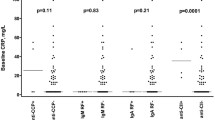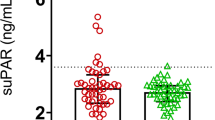Abstract
We followed the levels of serum IgA-alpha-1-antitrypsin (IgA-AT) complex in 37 patients with early rheumatoid arthritis (RA) during the first 3 years of the disease. The changes in IgA-AT were correlated with a radiological damage score (DS) of the hands assessed according to Larsen. At the onset of the disease, the IgA-AT serum concentration was significantly higher as compared to the control group (0.72±0.22 U vs 0.29±0.14 U, P<0.01). The level significantly decreased during the 3-year observation period. The DS was significantly higher after 3 years. However, this difference was due to changes in only 11 patients; in 26 patients the DS was almost unchanged. In the group of 11 patients with radiological progression, the level of IgA-AT either remained high or increased significantly (0.95±0.18 U at the onset, 0.97±0.25 U after 3 years), whereas we observed a decrease in IgA-AT in 26 patients without radiological progression (0.63±0.16 U at the onset of the disease, 0.45±0.10 U after 3 years, P<0.01). Moreover, a relationship between changes in IgA-AT serum level and radiological progression was shown (r=0.60, P<0.01). Our studies suggested that the relationship between IgA-AT level and radiological progression of the disease should be considered. We cannot exclude the possibility that the constant high level of IgA-AT may cause worsening in bone erosions.
Similar content being viewed by others
References
Larsen A, Thoen J (1987) Hand radiography of 200 patients with rheumatoid arthritis repeated after an interval of one year. Scand J Rheumatol 16:395–401
Sjoblom KG, Saxne S, Pettersson H, Wallheim FA (1994) Factors related to the progression of the joint destruction in rheumatoid arthritis. Scand J Rheumatol 13:21–27
Scott DL, Coulton BL, Popert AJ (1986) Long term progression of joint damage in rheumatoid arthritis. Ann Rheum Dis 45:373–378
Sherrer YS, Bloch DA, Mitchell DM, Young DY, Fries JF (1986) The development of disability in rheumatoid arthritis. Arthritis Rheum 29:494–500
Stanworth DR (1985) IgA dysfunction in rheumatoid arthritis. Immunol Today 6:43–45
Tomasi TH, Hauptman S (1974) The binding of alpha 1-antitrypsin to human IgA. J Immunol 112:2274–2277
Davis MJ, Dawes PT, Fowler PD, Shadforth MF, Stanworth DR (1991) The association and predictive value of the complex immunoglobulin A-alpha-1 antitrypsin in the development of erosions in early rheumatoid arthritis. Scand J Rheumatol 20:23–27
Dawes PT, Jackson R, Shadforth MF, Lewin IV, Stanworth DR (1987) The relationship between the complex of immunoglobulin A and alpha-1-antitrypsin, its constituent components and the acute-phase response as measured by C-reactive protein in rheumatoid arthritis treated with gold or D-penicillamine. Br J Rheumatol 26:351–353
Davis MJ, Dawes PT, Beswick E, Lewin IV, Stanworth DR (1989) Sulphasalizine therapy in ankylosing spondylitis: its effect on disease activity, immunoglobulin A and the complex immunoglobulin A alpha-1-antitrypsin. Br J Rheumatol 28:410–413
Struthers GR, Lewin IV, Stanworth DR (1989) IgA-alpha-1 antitrypsin complex in ankylosing spondylitis. Ann Rheum Dis 48:30–34
Laurell CB, Grubb A, Thulin E (1976) J chain and alpha-1-antitrypsin complex in sera with poly- and monoclonal IgA. Ric Clin Lab 6 [Suppl 3]:57–67
Stanworth DR (1981) The effect of D-penicillamine treatment on humoral immunological factors in clinical and experimental arthritis. In: Maini R, Barry H (eds) Modulation of autoimmunity and disease. Praeper, New York, pp 31–35
Arnet FC, Edworthy SM, Bloch DA, McShane DJ, Fries JF, Cooper NS, Healey LA, Kaplan SR, Liang MH, Luthra HS, Medsper TA, Mithchel DM, Neustadt DH, Pinals RS, Schaller JG, Sharp JT, Wilder RL, Hunder GG (1988) The American Rheumatism Association 1987 revised criteria for the classification of rheumatoid arthritis. Arthritis Rheum 31:315–324
Mallya RK, Mace BEW (1981) The assessment of disease activity in rheumatoid arthritis using a multivariate analysis. Rheumatol Rehabil 20:14–17
Lansbury J, Haut DD (1956) Quantitation of the manifestations of rheumatoid arthritis. Area of joint surfaces as an index to total joint inflammation and deformity. Am J Med Sci 232:150–155
Amos RS, Constable TS, Crockson RA, et al (1977) Rheumatoid arthritis: relation of serum C-reactive protein and erythrocyte sedimentation rates to radiographic changes. BMJ 1:195–197
de Carralno A, Grandal H (1980) Radiographic progression of RA related to some clinical and laboratory parameters. Acta Radiol Diagn 21:551–555
Larsen A (1988) The relation of radiographic changes to serum acute phase proteins and rheumatoid factor in 200 patients with rheumatoid arthritis. Scand J Rheumatol 17:123–129
Delemere JP, Farr M, Grindulis KA (1983) Sulphasalazine induced selective IgA deficiency in rheumatoid arthritis. BMJ 286:1547–1549
Far M, Struthers GR, Scott DGI, Bacon PA (1985) Fenclofenac inducded selective IgA deficiency in rheumatoid arthritis. Br J Rheumatol 24:367–369
Barden J, Mullinax F, Waller M (1967) Immunoglobulin levels in rheumatoid arthritis: comparison with rheumatoid factor titres, clinical stage and disease duration. Arthritis Rheum 3:228–234
Abboud RT, Chalmers A, Gofton JP, Richter AM, Enarson DA (1991) Relationship between severity of rheumatoid arthritis and serum alpha-1-antitrypsin. J Rheumatol 18:1490–1495
Author information
Authors and Affiliations
Rights and permissions
About this article
Cite this article
Lacki, J.K., Schochat, T., Müller, W. et al. Does the serum level of IgA-alpha-1-antitrypsin complex correlate with radiological progression in early rheumatoid arthritis? A 3-year follow-up study. Rheumatol Int 14, 227–230 (1995). https://doi.org/10.1007/BF00262087
Received:
Accepted:
Issue Date:
DOI: https://doi.org/10.1007/BF00262087




